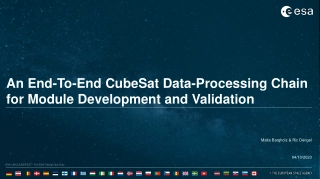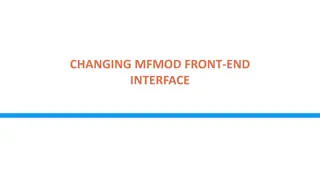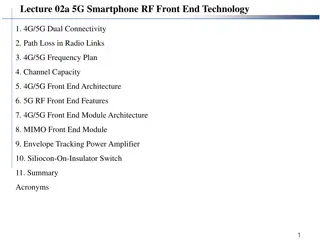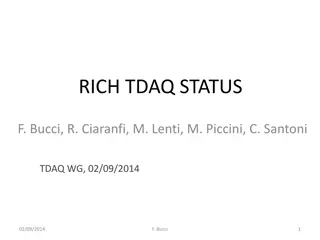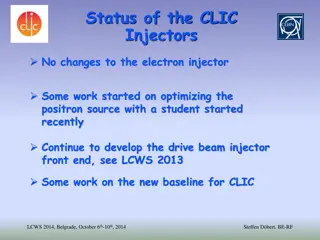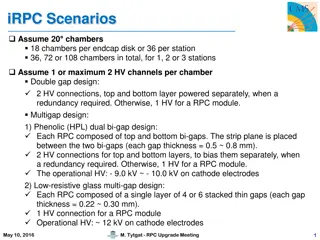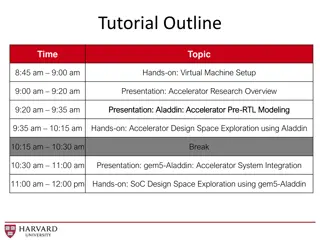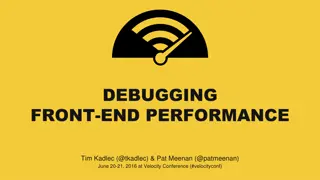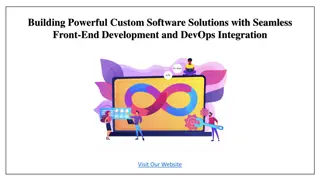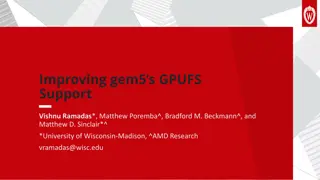
Modern Front-end Support in gem5: Advancements in CPU Architecture
Explore the innovative use of decoupled front-end architecture in modern CPUs to enhance performance and mitigate latency issues. Delve into cutting-edge techniques in branch prediction, instruction fetch, and prefetching for optimized processing efficiency.
Download Presentation

Please find below an Image/Link to download the presentation.
The content on the website is provided AS IS for your information and personal use only. It may not be sold, licensed, or shared on other websites without obtaining consent from the author. If you encounter any issues during the download, it is possible that the publisher has removed the file from their server.
You are allowed to download the files provided on this website for personal or commercial use, subject to the condition that they are used lawfully. All files are the property of their respective owners.
The content on the website is provided AS IS for your information and personal use only. It may not be sold, licensed, or shared on other websites without obtaining consent from the author.
E N D
Presentation Transcript
Modern Front-end Support in gem5 Bhargav Reddy Godala, Nayana Prasad Nagendra, Ishita Chaturvedi, Simone Campanoni, David I. August PRINCETON UNIVERSITY Liberty Arcana Research Group Research Group
Introduction We have seen that aggressive Out-of-Order CPUs tolerate data miss latency. Modern CPUs employ decoupled front-end to tolerate instruction miss latency. What is a decoupled front-end?
State-of-Art Front-end Branch Re-steer Address Fetch Engine NIP Decode BPU Back-end IAG I-Cache IFU Front-end Traditional Front-end FTQ: Fetch Target Queue IFU: Instruction Fetch Unit BPU: Branch Prediction Unit IAG: Instruction Address Generation NIP: Next Instruction Pointer 3 EMISSARY, Nagendra and Godala, et al.
State-of-Art Front-end Branch Re-steer Address IFU FTQ Fetch Engine NIP Decode BPU Back-end IAG Prefetch I-Cache Front-end Fetch Directed Instruction Prefetching Pipeline (FDIP) [Glenn Reinman et al.,MICRO 99] FTQ: Fetch Target Queue IFU: Instruction Fetch Unit BPU: Branch Prediction Unit IAG: Instruction Address Generation NIP: Next Instruction Pointer Key Idea: Prefetch in the predicted path 3 EMISSARY, Nagendra and Godala, et al.
Challenges in Implementing FDIP in gem5 Fetch stage is already complex. Dynamic Instruction objects are constructed before BPU is invoked. Branch Instruction is needed to invoke BPU. Sequence numbers are used to squash mis-speculated instructions.
Branch Sequence Numbers Unique sequence number to identify branch. BrSeq Seq 10 10 10 10 11 11 11 11 Seq Instruction Every dynamic instruction contains: 100 101 102 103 104 105 106 107 Br I0 I1 I2 Br I3 I4 I5 A sequence number Branch Sequence of prior branch
Fetch Target Queue (FTQ) Each entry consists of: A begin address (target of prior branch) End address (branch PC) Target address Branch Sequence number
Prefetch Engine Prefetch Buffer: FTQ F2 F1 F0 Address to prefetch F3 F1 F0 Issue one prefetch and insert into Fetch Buffer Prefetch Buffer L6 L5 L4 L3 L2 L1 L0 Fetch Buffer L3 L2 L1 L0 Prefetch request issued Pending Ready
Basic Block Based BTB Index target1 target2 Target target2 target3 Branch br2 br3 Index br1 br2 br3 Traget target1 target2 Target3 BBL based BTB PC based BTB
Pre-decode And Early Correction BBL BTB are indexed using beginning of a basic block. Beginning of a basic block is identified: Using the next instruction following a branch instruction. Early Correction: When an unconditional branch is predicted not taken. Flush FTQ and restart by using the pre-decoded target.
Branch Predictor Changes BBL Based Branch Predictor lookup. Branch Sequence numbers. ITTAGE indirect predictor support.
X86 vs ARM ARM: X86: Fixed width instructions Variable width instructions Pre-decoding is not expensive Pre-decoding is very expensive Micro Sequenced Ops Exception handling using ROM
Micro Branches in X86 In X86 there are instructions which are dynamically decoded to loops. Example: String copy These branches are not inserted into BTB. This is handled as a special case: These are not seen by the FDIP pipeline. At the time of fetch; a back edge is predicted taken. FTQ will not be flushed till a squash from later stages is received.
Performance Bug Fixes Perfect recovery of branch history. TAGE Bimodal table roll back.
Performance of ARM workloads with FDIP Field Alderlake like ISA ARM 64-bit L1I 32KB L1D 64KB L2 1MB (16-way) L3 2MB FTQ 24 entry 192 inst Width 8-wide ROB Size 512 entries IQ/LQ/SQ 240/128/72 BPU TAGE, ITTAGE BTB gem5 O3 CPU simulation parameters 16K entries IPC Performance improvement of ARM workloads in % over No FDIP baseline
Performance of X86 workloads with FDIP Field Alderlake like ISA X86 64-bit L1I 32KB L1D 64KB L2 1MB (16-way) L3 2MB FTQ 24 entry 192 inst Width 8-wide ROB Size 512 entries IQ/LQ/SQ 240/128/72 BPU TAGE, ITTAGE BTB gem5 O3 CPU simulation parameters 16K entries IPC Performance improvement of X86 workloads in % over No FDIP baseline
Performance of X86 SPEC17 workloads with FDIP Field Alderlake like ISA X86 64-bit L1I 32KB L1D 64KB L2 1MB (16-way) L3 2MB FTQ 24 entry 192 inst Width 8-wide ROB Size 512 entries IQ/LQ/SQ 240/128/72 BPU TAGE, ITTAGE BTB gem5 O3 CPU simulation parameters 16K entries IPC Performance improvement of X86 SPEC17 workloads in % over No FDIP baseline
Published Works EMISSARY: Enhanced Miss Awareness Replacement Policy for L2 Instruction Caching at ISCA 23 Session 2B
Conclusion We implemented FDIP in gem5. A significant speedup over baseline. This work was used in EMISSARY [ISCA 23]. Available at https://github.com/PrincetonUniversity/gem5_FDIP Workloads: https://tinyurl.com/yjsc2aw4 gem5 + FDIP Workloads
Thank you Questions?

